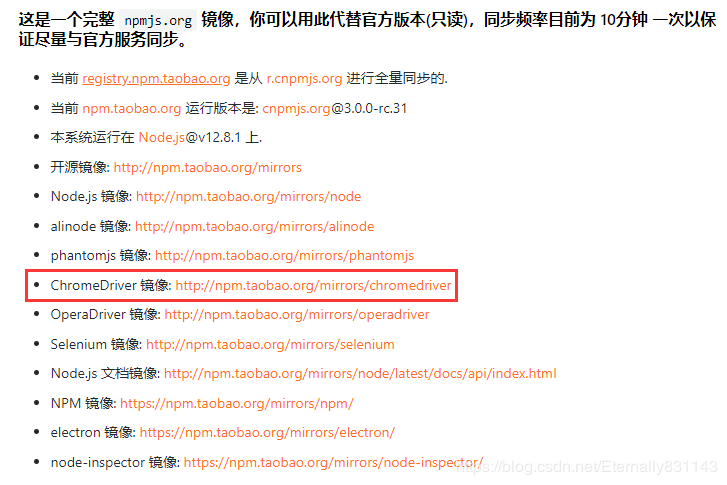前言
近几日迫于被辅导员三番五次的提醒每日一报打卡,就想着去写个脚本挂在服务器上定时执行。经过我不懈的努力,最终选择了seleniumseleniumselenium,因为简单(
安装selenium库
$ sudo pip install selenium
安装chromdriver
因为我有代理所以直接在官网下载的,那这里你可以选择用淘宝镜像源。
这里为了方便,我直接放命令了。Chromedriver版本我这里选择的是80.0.3987.16(注意要和一会儿下载的Chrome版本一致)。
下载
$ wget https://npm.taobao.org/mirrors/chromedriver/80.0.3987.16/chromedriver_linux64.zip
解压
$ unzip chromedriver_linux64.zip -d .
放到相应目录并授予可执行权限
$ sudo cp chromedriver /usr/bin && sudo chmod +x /usr/bin/chromedriver
安装Chrome安装依赖
$ sudo apt-get install libxss1 libappindicator1 libindicator7
安装Chrome
$ wget https://dl.google.com/linux/direct/google-chrome-stable_current_amd64.deb$ sudo dpkg -i google-chrome*.deb$ sudo apt-get install -f
查看版本
$ google-chrome –version
测试调试
$ google-chrome –headless –remote-debugging-port=9222 https://chromium.org –disable-gpu
编写脚本创建脚本并授予权限
$ touch dailyReport.py && touch dailyReport.log && sudo chmod +x dailyReport.py
内容
# encoding=utf8 from selenium import webdriver from selenium.common.exceptions import NoSuchElementException import time class DailyReport(object): def __init__(self): self.chrome_options = webdriver.ChromeOptions() self.chrome_options.add_argument(\'--headless\') self.chrome_options.add_argument(\'--disable-gpu\') self.chrome_options.add_argument(\'--no-sandbox\') # 这个配置很重要 self.client = None # self.client = webdriver.Chrome(chrome_options=self.chrome_options) self.index_url = \'https://xxxxx/xxxx/login\' self.report_url = \'https://xxxx/xxxx/report\' self.data = [ (\'用户名\', \'密码\'), (\'xxxx\', \'xxxx\'), (\'xxxx\', \'xxxx\'), (\'xxxx\', \'xxxx\'), (\'xxxx\', \'xxxx\') ] def login(self, _username, _password): try: self.client = webdriver.Chrome(chrome_options=self.chrome_options) print(self.get_current_time() + \' \' + _username + u\'开始进行打卡\'.encode(\'utf-8\')) self.client.get(self.index_url) username = self.client.find_element_by_name(\"username\") password = self.client.find_element_by_name(\'password\') username.send_keys(_username) password.send_keys(_password) login_button = self.client.find_element_by_xpath(\'//*[@id=\"form1\"]/div[4]/button\') login_button.click() except NoSuchElementException: print(self.get_current_time(), u\'登录异常!\'.encode(\'utf-8\')) else: # time.sleep(2) print(self.get_current_time() + \' \' + u\'登录成功!\'.encode(\'utf-8\')) def post_data(self): try: self.client.get(self.report_url) submit_button = self.client.find_element_by_xpath(\'//*[@id=\"p1_ctl00_btnSubmit\"]/span/span\') submit_button.click() ensure_button = self.client.find_element_by_xpath(\'//*[@id=\"fineui_26\"]/span/span\') ensure_button.click() # print (client.page_source.encode(\'utf-8\')) except NoSuchElementException: print(self.get_current_time(), u\' 提交表单异常! 打卡失败!\'.encode(\'utf-8\')) else: # time.sleep(2) print(self.get_current_time() + \' \' + u\'打卡成功!\\n\'.encode(\'utf-8\')) finally: time.sleep(5) self.client.quit() print(u\'浏览器退出...\\n--------------\\n\'.encode(\'utf-8\')) def run(self): for msg in self.data: self.login(msg[0], msg[1]) self.post_data() print(\'Python script completed at \' + self.get_current_time() + \'\\n--------------\\n\') @staticmethod def get_current_time(): return time.strftime(\"%Y-%m-%d %H:%M:%S\", time.localtime()) if __name__ == \'__main__\': obj = DailyReport() obj.run()
脚本内容需要根据不同网站做对应的修改。
脚本定时执行
这里我们利用LinuxLinuxLinux的内置命令crontabcrontabcrontab,关于crontabcrontabcrontab的用法请自行百度ororor谷歌。
$ crontab -e
如果是首次使用,应该会让你选择编辑器,我选择的vimvimvim,然后在最后一行加入一行
0 0 * * * python ~/dailyReport.py >> ~/dailyReport.log
这样就可以做到每天00:0000:0000:00自动执行脚本了。
注
Chrome在服务器端运行参考博文:https://www.jb51.net/article/183899.htm
到此这篇关于Python + selenium + crontab实现每日定时自动打卡的文章就介绍到这了,更多相关python 定时自动打卡内容请搜索自学编程网以前的文章或继续浏览下面的相关文章希望大家以后多多支持自学编程网!














